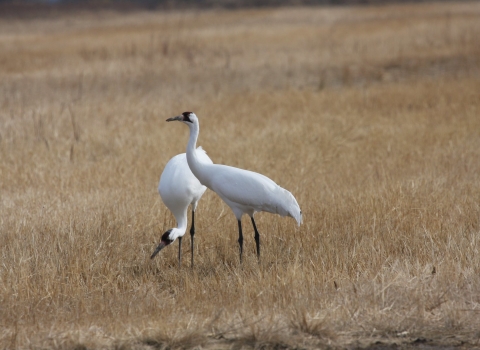Will Protect Millions of Seabirds, Coconut Crabs, and
one of the Largest Remaining Tropical Coastal Strand Forests in the Pacific
The U.S. Fish and Wildlife Service (FWS), The Nature Conservancy (TNC), and Island Conservation (IC) today announced that summer 2011 fieldwork to restore Palmyra Atoll by removing destructive, non-native rats was just completed safely and efficiently, along with the first phase of scientific monitoring. The restoration project aims to protect 10 nesting seabird species, migratory shorebirds, the rare coconut crab, and one of the largest remaining native Pisonia forests in the Pacific Islands.
Palmyra Atoll, approximately 1,000 miles south of Honolulu, Hawai‘i, is cooperatively managed by the FWS and TNC as a National Wildlife Refuge and a small research station. Research done at Palmyra can help inform conservation strategies around the world by providing essential information about how healthy ecosystems respond to global climate change climate change
Climate change includes both global warming driven by human-induced emissions of greenhouse gases and the resulting large-scale shifts in weather patterns. Though there have been previous periods of climatic change, since the mid-20th century humans have had an unprecedented impact on Earth's climate system and caused change on a global scale.
Learn more about climate change , invasive species invasive species
An invasive species is any plant or animal that has spread or been introduced into a new area where they are, or could, cause harm to the environment, economy, or human, animal, or plant health. Their unwelcome presence can destroy ecosystems and cost millions of dollars.
Learn more about invasive species , and marine restoration, to name a few. Scientists are also learning how healthy ecosystems function free from human influences such as pollution and overfishing.
In June 2011, personnel and contractors from FWS, TNC, Island Conservation, the U.S. Department of Agriculture, and the U.S. Geological Survey, successfully carried out the application of bait to remove destructive rats from the 25 islets that comprise the atoll, while minimizing threats from the bait to other animals. The operations followed extensive planning outlined in FWS’s May 2011 Environmental Impact Statement and was supported by years of scientific research. Comprehensive monitoring will take place over the next two years to assess the status of the eradication effort and how the atoll responds to rat removal. Several researchers returned to the atoll in August and completed the first phase of monitoring. After deploying hundreds of detection devices throughout the atoll, no signs of rats were found.
“Although it will be 2 years before we can confirm rat removal, the operations were a great achievement, having been carried out both safely and efficiently” said Susan White, Project Leader of the Pacific Reefs National Wildlife Refuge Complex and operations Incident Commander. “Each aspect of the project and each person on our 41-person team of highly skilled and dedicated professionals was essential to achieving this goal in such a complex and challenging environment as Palmyra.”
Black rats, likely introduced to the atoll during World War II, prey upon ground-nesting and tree-nesting birds, consuming eggs and chicks. Rats are also likely responsible for the absence of several species of burrow-nesting seabirds such as shearwaters and petrels that would likely otherwise breed at Palmyra. Rats compete for food with shorebirds, attack native land crabs, and eat the seeds and seedlings of native trees.
“The lessons learned from removing invasive rats from Palmyra Atoll is critical to the survival of seabirds and native species on islands around the world. Following upon successful projects in temperate climates, like Anacapa Island in the Channel Islands National Park and Rat Island in the Alaska Maritime National Wildlife Refuge, the methods developed for and proven at Palmyra set a precedent for subsequent efforts to restore other tropical islands, protecting species in places where it might have seemed impossible before,” according to Bill Waldman, Island Conservation’s Executive Director.
The project goal was to expose every rat on the atoll to bait while mitigating impacts to native species. The project partners were particularly concerned about the potential for exposing native geckos and shorebirds to bait. As a precautionary measure, project staff held geckos in captivity during the month of June and successfully returned them to their respective islets after operations finished.
Project team members also were some of the first people to successfully capture and care for bristle-thighed curlews in captivity. In an effort to protect as many shorebirds as possible from potential exposure to the rodenticide, 13 curlews and one Pacific golden plover were captured and cared for between early June and early August. All 14 birds were safely released back to the wild on August 4th. Of the 13 curlews that were in captive care, 8 have been spotted since their release, having joined flocks of non-captured birds. The scientific knowledge gained through this capture and care provides significant contributions to future conservation programs focused on bristle-thighed curlews and other shorebirds.
Partners are cautiously encouraged by daily indicators of a rat-free Palmyra. Sooty terns, native trees, insects, various invertebrates and crab populations all appear to be flourishing.
The Palmyra Atoll Restoration Project was also part of a unique collaborative partnership to restore a series of islands in the Pacific in 2011, including Palmyra Atoll (USA), several islands in the Phoenix Islands Protected Area (Republic of Kiribati), and Henderson Island (Pitcairn Islands) by the Royal Society for the Protection of Birds. A combined expedition allowed three projects to share a support vessel (the Research Vessel Aquila), helicopters, equipment, and some personnel. All three projects were focused on safeguarding native animals and plants by removing introduced invasive rats. The last of the three projects was completed at the end of August and the crew and the Research vessel Aquila are headed home.
For more information about Palmyra Atoll Restoration Project, visit www.protectpalmyra.org.


